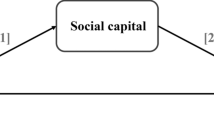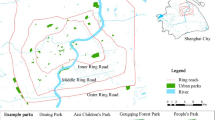Abstract
This research investigates how access to eight urban amenities impacts people’s satisfaction with the urban environment in four new towns close to Seoul, the capital of South Korea. A Structural Equation Model (SEM) is used to analyze how the objective environment affects satisfaction with the urban environment through factors such as the perceived evaluation of the objective environment. The findings indicate that having easy access to urban parks, schools, shop** facilities, medical service facilities, and sports facilities is linked to higher levels of satisfaction with the urban environment. While some amenities indirectly affect satisfaction, shop** and sports facilities have a direct and indirect effect on overall satisfaction. The study also suggests that while people’s perception of crime prevention influences satisfaction with the urban environment, accessibility to police stations does not have a significant impact on satisfaction with either crime prevention or the urban environment, highlighting the need to identify other factors that influence satisfaction with crime prevention measures. Overall, the research provides evidence to support the importance of proximity to urban amenities, and identifies which amenities are crucial to enhance the quality of urban life.




Similar content being viewed by others
Data Availability
Data will be made available on request.
References
Amérigo, M., & Aragonés, J. I. (1990). Residential satisfaction in council housing. Journal of Environmental Psychology, 10(4), 313–325. https://doi.org/10.1016/S0272-4944(05)80031-3
Anton, C. E., & Lawrence, C. (2014). Home is where the heart is: The effect of place of residence on place attachment and community participation. Journal of Environmental Psychology, 40, 451–461. https://doi.org/10.1016/j.jenvp.2014.10.007
Blanchflower, D. G., & Oswald, A. J. (2004). Well-being over time in Britain and the USA. Journal of Public Economics, 88(7–8), 1359–1386. https://doi.org/10.1016/S0047-2727(02)00168-8
Brantingham, P. L., & Brantingham, P. J. (1993). Nodes, paths and edges: Considerations on the complexity of crime and the physical environment. Journal of Environmental Psychology, 13(1), 3–28.
Browne, M., & Cudeck, R. (1993). Alternative ways of assessing model fit. In K. A. Bollen & J. S. Long (Eds.), Testing structural equation models (pp. 136–162). Sage Publications.
Campbell, A., Converse, P. E. E., Rodgers, W. L. L., Cambell, A., Converse, P. E. E., & Rodgers, W. L. L. (1976). The quality of American life: Perceptions, evaluations, and satisfactions. Russell Sage Foundation.
Cannon, W. B. (1929). Organization for physiological homeostasis. Physiological Reviews, 9(3), 399–431.
Cao, X. J. (2016). How does neighborhood design affect life satisfaction? Evidence from Twin Cities. Travel Behaviour and Society, 5, 68–76. https://doi.org/10.1016/j.tbs.2015.07.001
Cao, X., Wu, X., & Yuan, Y. (2018). Examining Built Environmental Correlates of Neighborhood Satisfaction: A Focus on Analysis Approaches. Journal of Planning Literature, 33(4), 419–432. https://doi.org/10.1177/0885412218765443
Chen, F. F. (2007). Sensitivity of goodness of fit indexes to lack of measurement invariance. Structural Equation Modeling, 14(3), 464–504. https://doi.org/10.1080/10705510701301834
Cook, C. C. (1988). Components of Neighborhood Satisfaction: Responses from urban and suburban single-parent women. Environment and Behavior, 20(2), 115–149. https://doi.org/10.1177/0013916588202001
DeNeve, K. M., & Cooper, H. (1998). The happy personality: A meta-analysis of 137 personality traits and subjective well-being. Psychological Bulletin, 124(2), 197.
Duany, A., & Playter-Zyberk, E. (1992). The second coming of the small town. Wilson Quarterly, 16(1), 3–51.
Ettema, D., & Schekkerman, M. (2016). How do spatial characteristics influence well-being and mental health? Comparing the effect of objective and subjective characteristics at different spatial scales. Travel Behaviour and Society, 5, 56–67. https://doi.org/10.1016/j.tbs.2015.11.001
Grogan-Kaylor, A., Woolley, M., Mowbray, C., Reischl, T. M., Gilster, M., Karb, R., … Alaimo, K. (2006). Predictors of Neighborhood Satisfaction. Journal of Community Practice, 14(4), 27–50. https://doi.org/10.1300/J125v14n04_03
Hamidi, S., Ewing, R., Preuss, I., & Dodds, A. (2015). Measuring sprawl and its impacts: An update. Journal of Planning Education and Research, 35(1), 35–50. https://doi.org/10.1177/0739456X14565247
Handy, S. L. (1993). Regional versus local acessibility: Implications for nonwork travel. Transportation Research Record, 1400, 58–66. https://onlinepubs.trb.org/Onlinepubs/trr/1993/1400/1400-009.pdf
Heller, D., Watson, D., & Ilies, R. (2004). The role of person versus situation in life satisfaction: A critical examination. Psychological Bulletin, 130(4), 574.
Hidalgo, M. C., & Hernández, B. (2001). Place attachment: Conceptual and empirical questions. Journal of Environmental Psychology, 21(3), 273–281. https://doi.org/10.1006/jevp.2001.0221
Hsieh, C. (2003). Counting Importance: The Case of Life Satisfaction and Relative Domain Importance. Social Indicators Research, 61, 227–240. https://doi.org/10.1023/A:1021354132664
Hu, L. T., & Bentler, P. M. (1999). Cutoff criteria for fit indexes in covariance structure analysis: Conventional criteria versus new alternatives. Structural Equation Modeling, 6(1), 1–55. https://doi.org/10.1080/10705519909540118
Korea Land and Housing Corporation. (2020). Spatial Information Portal.
Lovejoy, K., Handy, S., & Mokhtarian, P. (2010). Neighborhood satisfaction in suburban versus traditional environments: An evaluation of contributing characteristics in eight California neighborhoods. Landscape and Urban Planning, 97(1), 37–48. https://doi.org/10.1016/j.landurbplan.2010.04.010
Mackerron, G. (2012). Happiness economics from 35000 feet. Journal of Economic Surveys, 26(4), 705–735. https://doi.org/10.1111/j.1467-6419.2010.00672.x
Marans, R. W., & Rodgers, W. (1975). Towards an understanding of community satisfaction. Metropolitan America in contemporary perspective, 1, 299–352.
Marans, Robert W., & Stimson, R. J. (2011). Investigating quality of urban life: Theory, methods, and empirical research. Springer Science & Business Media.
McCrea, R., Stimson, R., & Western, J. (2005). Testing a moderated model of satisfaction with urban living using data for Brisbane-South East Queensland. Australia. Social Indicators Research, 72(2), 121–152. https://doi.org/10.1007/s11205-004-2211-x
McCrea, R., Shyy, T. K., & Stimson, R. (2006). What is the strength of the link between objective and subjective indicators of urban quality of life? Applied Research in Quality of Life, 1(1), 79–96. https://doi.org/10.1007/s11482-006-9002-2
McCrea, R., Shyy, T. K., & Stimson, R. J. (2014). Satisfied Residents in different types of local Areas: Measuring what’s most important. Social Indicators Research, 118(1), 87–101. https://doi.org/10.1007/s11205-013-0406-8
McDonald, R. P., & Marsh, H. W. (1990). Choosing a multivariate model: Noncentrality and goodness of fit. Psychological Bulletin, 107(2), 247–255. https://doi.org/10.1037/0033-2909.107.2.247
Mouratidis, K. (2018). Is compact city livable? The impact of compact versus sprawled neighbourhoods on neighbourhood satisfaction. Urban Studies, 55(11), 2408–2430. https://doi.org/10.1177/0042098017729109
Pavot, W., & Diener, E. (2008). The Satisfaction With Life Scale and the emerging construct of life satisfaction. Journal of Positive Psychology, 3(2), 137–152. https://doi.org/10.1080/17439760701756946
Shafer, C. S., Lee, B. K., & Turner, S. (2000). A tale of three greenway trails: User perceptions related to quality of life. Landscape and Urban Planning, 49(3–4), 163–178. https://doi.org/10.1016/S0169-2046(00)00057-8
Sirgy, M. J., & Cornwell, T. (2002). How Neighborhood Features Affect Quality of Life. Social Indicators Research, 59, 79–114. https://doi.org/10.1023/A:1016021108513
Steel, P., Schmidt, J., & Shultz, J. (2008). Refining the Relationship Between Personality and Subjective Well-Being. Psychological Bulletin, 134(1), 138–161. https://doi.org/10.1037/0033-2909.134.1.138
Sugiyama, T., Thompson, C. W., & Alves, S. (2009). Associations Between Neighborhood Open Space Attributes and Quality of Life for Older People in Britain. Environment And Behavior, 41(1), 3–21. https://doi.org/10.1177/0013916507311688
Türksever, A. N. E., & Atalik, G. (2001). Possibilities and Limitations for the Measurement of the Quality of Life in Urban Areas. Social Indicator Research, 53(2), 163–187.
Williams, D. R., Patterson, M. E., Roggenbuck, J. W., & Watson, A. E. (1992). Beyond the commodity metaphor: Examining emotional and symbolic attachment to place. Leisure Sciences, 14(1), 29–46. https://doi.org/10.1080/01490409209513155
Yang, Y. (2008). A tale of two cities: Physical form and neighborhood satisfaction in Metropolital Portland and Charlotte. Journal of the American Planning Association, 74(3), 307–323. https://doi.org/10.1080/01944360802215546
Zhang, C., & Lu, B. (2016). Residential satisfaction in traditional and redeveloped inner city neighborhood: A tale of two neighborhoods in Bei**g. Travel Behaviour and Society, 5, 23–36. https://doi.org/10.1016/j.tbs.2015.08.001
Acknowledgements
This research utilized some of the contents of ‘A Study on the Comprehensive Evaluation of the first and second Phase of New Towns (research number 2021-93)’, supported by the Land and Housing Research Institute (Republic of Korea).
Funding
This research was supported by the Chung -Ang University Research Grants in 2023 and this work was supported by a National Research Foundation of Korea (NRF) grant, funded by the Korea government (MSIT) (No. 2022R1C1C1008627).
Author information
Authors and Affiliations
Corresponding author
Ethics declarations
Conflicts of Interest
On behalf of all authors, the corresponding author states that there is no conflict of interest.
Additional information
Publisher's Note
Springer Nature remains neutral with regard to jurisdictional claims in published maps and institutional affiliations.
Rights and permissions
Springer Nature or its licensor (e.g. a society or other partner) holds exclusive rights to this article under a publishing agreement with the author(s) or other rightsholder(s); author self-archiving of the accepted manuscript version of this article is solely governed by the terms of such publishing agreement and applicable law.
About this article
Cite this article
Lee, C., Choi, S. & Yoon, J. The Influence of Access to Urban Amenities on Urban Environment Satisfaction: A Case Study of Four New Towns in the Vicinity of Seoul, South Korea. Applied Research Quality Life 18, 3111–3139 (2023). https://doi.org/10.1007/s11482-023-10223-7
Received:
Accepted:
Published:
Issue Date:
DOI: https://doi.org/10.1007/s11482-023-10223-7




